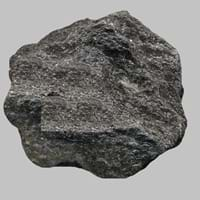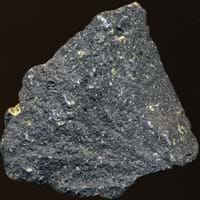Definition
A ganister is a hard, fine-grained quartzose sandstone or orthoquartzite which is basically used in the manufacture of silica brick typically used to line furnaces and is a type of sedimentary rocks.
Basalt is a common extrusive igneous rock formed by the rapid cooling of basaltic lava exposed at or very near the surface of Earth
Discoverer
Unknown
Georgius Agricola
Etymology
From gan′is-ter i.e a hard, close-grained siliceous stone, often forming the stratum which underlies a coal-seam
From Late Latin Basaltes (variant of basanites ), very hard stone, which was imported from Ancient Greek Basanites
Class
Sedimentary Rocks
Igneous Rocks
Sub-Class
Durable Rock, Hard Rock
Durable Rock, Medium Hardness Rock
Group
Not Applicable
Volcanic
Other Categories
Coarse Grained Rock, Fine Grained Rock, Opaque Rock
Fine Grained Rock, Opaque Rock
Texture
Clastic, Granular, Rough
Glassy, Massive, Porphyritic, Scoriaceous, Vesicular
Color
Beige, Black, Brown, Colourless, Cream, Dark Brown, Green, Grey, Light Green, Light to Dark Grey, Pink, Red, White, Yellow
Black, Brown, Light to Dark Grey
Durability
Durable
Durable
Scratch Resistant
Yes
Yes
Appearance
Rough
Dull and Soft
Interior Uses
Decorative Aggregates, Entryways, Flooring, Homes, Interior Decoration
Floor Tiles, Homes, Hotels, Kitchens
Exterior Uses
As Building Stone, Garden Decoration, Office Buildings, Paving Stone
As Building Stone, Paving Stone, Garden Decoration, Office Buildings
Other Architectural Uses
Curbing
Curbing, Whetstones
Construction Industry
Cement Manufacture, Construction Aggregate, for Road Aggregate, Production of Glass and Ceramics, Raw material for the manufacture of mortar
Arrowheads, As Dimension Stone, Cobblestones, Cutting Tool, Rail Track Ballast, Roadstone
Medical Industry
Not Yet Used
Not Yet Used
Antiquity Uses
Artifacts, Monuments, Sculpture, Small Figurines
Artifacts, Monuments
Commercial Uses
An Oil and Gas Reservoir, In aquifers, Petroleum reservoirs, Soil Conditioner, Source of Magnesia (MgO), Tombstones
An Oil and Gas Reservoir, Commemorative Tablets, Creating Artwork, Used in aquariums
Types
Not Available
Alkaline Basalt, Boninite, High Alumina Basalt, Mid Ocean Ridge Basalt (MORB), Tholeiitic Basalt, Basaltic trachyandesite, Mugearite and Shoshonite
Features
Available in Lots of Colors and Patterns, Generally rough to touch, Very fine grained rock
Has High structural resistance against erosion and climate, Very fine grained rock
Archaeological Significance
Famous Monuments
Data Not Available
Easter Island in the Polynesian Triangle, Pacific Ocean, Gateway of India in Mumbai, India, Gol Gumbaz in Karnataka, India
Famous Sculptures
Data Not Available
Data Not Available
Pictographs
Not Used
Used
Petroglyphs
Not Used
Used
Formation
Ganisters are formed by the destruction of easily weathered minerals mainly feldspar, within the surface horizon of soil by soil-forming processes.
Basalt forms when lava reaches the Earth's surface near an active volcano. The temperature of lava is between 1100 to 1250° C when it gets to the surface.
Mineral Content
Calcite, Clay, Clay Minerals, Feldspar, Micas, Quartz
Olivine, Plagioclase, Pyroxene
Compound Content
Aluminium Oxide, CaO, Iron(III) Oxide, Potassium Oxide, MgO, Sodium Oxide, Silicon Dioxide
Aluminium Oxide, CaO, Iron(III) Oxide, FeO, Potassium Oxide, MgO, MnO, Sodium Oxide, Phosphorus Pentoxide, Silicon Dioxide, Titanium Dioxide
Types of Metamorphism
Not Applicable
Contact Metamorphism
Types of Weathering
Biological Weathering
Biological Weathering
Types of Erosion
Water Erosion, Wind Erosion
Not Available
Grain Size
Coarse or Fine
Fine Grained
Fracture
Splintery
Conchoidal
Streak
White
White to Grey
Porosity
Highly Porous
Less Porous
Luster
Dull
Not Available
Cleavage
Perfect
Not Available
Specific Gravity
2.2-2.8
2.8-3
Transparency
Opaque
Opaque
Density
2.2-2.8 g/cm3
2.9-3.1 g/cm3
Resistance
Heat Resistant, Impact Resistant, Pressure Resistant
Heat Resistant, Pressure Resistant, Wear Resistant
Deposits in Eastern Continents
Asia
China, India, Kazakhstan, Mongolia, Russia, Uzbekistan
India, Russia
Africa
Namibia, Nigeria, South Africa
South Africa
Europe
Austria, Denmark, Germany, Great Britain, Netherlands, Norway, Poland, Sweden, Switzerland, United Kingdom
Iceland
Others
Greenland
Not Yet Found
Deposits in Western Continents
North America
Canada, USA
Canada, USA
South America
Brazil
Brazil
Deposits in Oceania Continent
Australia
New South Wales, New Zealand
Not Yet Found
Ganister vs Basalt Characteristics
Though some rocks look identical, they have certain characteristics which distinguish them from others. Characteristics of rocks include texture, appearance, color, fracture, streak, hardness etc. Ganister vs Basalt characteristics assist us to distinguish and recognize rocks. Also you can check about Properties of Ganister and Properties of Basalt. Learn more about Ganister vs Basalt in the next section. The interior uses of Ganister include Decorative aggregates, Entryways, Flooring, Homes and Interior decoration whereas the interior uses of Basalt include Floor tiles, Homes, Hotels and Kitchens. Due to some exceptional properties of Ganister and Basalt, they have various applications in construction industry. The uses of Ganister in construction industry include Cement manufacture, Construction aggregate, For road aggregate, Production of glass and ceramics, Raw material for the manufacture of mortar and that of Basalt include Arrowheads, As dimension stone, Cobblestones, Cutting tool, Rail track ballast, Roadstone.
More about Ganister and Basalt
Here you can know more about Ganister and Basalt. The life cycle of a rock consists of formation of rock, composition of rock and transformation of rock. The composition of Ganister and Basalt consists of mineral content and compound content. The mineral content of Ganister includes Calcite, Clay, Clay Minerals, Feldspar, Micas, Quartz and mineral content of Basalt includes Olivine, Plagioclase, Pyroxene. You can also check out the list of all Sedimentary Rocks. When we have to compare Ganister vs Basalt, the texture, color and appearance plays an important role in determining the type of rock. Ganister is available in beige, black, brown, colourless, cream, dark brown, green, grey, light green, light to dark grey, pink, red, white, yellow colors whereas, Basalt is available in black, brown, light to dark grey colors. Appearance of Ganister is Rough and that of Basalt is Dull and Soft. Properties of rock is another aspect for Ganister vs Basalt. The hardness of Ganister is 6-7 and that of Basalt is 6. The types of Ganister are Not Available whereas types of Basalt are Alkaline Basalt, Boninite, High Alumina Basalt, Mid Ocean Ridge Basalt (MORB), Tholeiitic Basalt, Basaltic trachyandesite, Mugearite and Shoshonite. Streak of rock is the color of powder produced when it is dragged across an unweathered surface. The streak of Ganister is white while that of Basalt is white to grey. The specific heat capacity of Ganister is 0.92 kJ/Kg K and that of Basalt is 0.84 kJ/Kg K. Depending on the properties like hardness, toughness, specific heat capacity, porosity etc., rocks are resistant to heat, wear, impact, etc.Ganister is heat resistant, impact resistant, pressure resistant whereas Basalt is heat resistant, pressure resistant, wear resistant.





